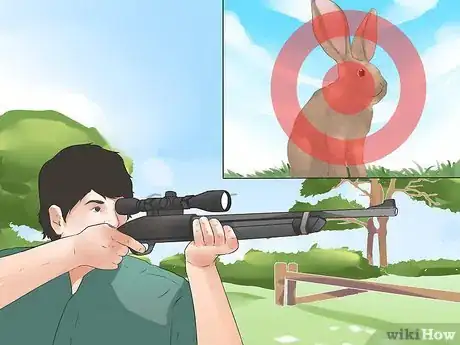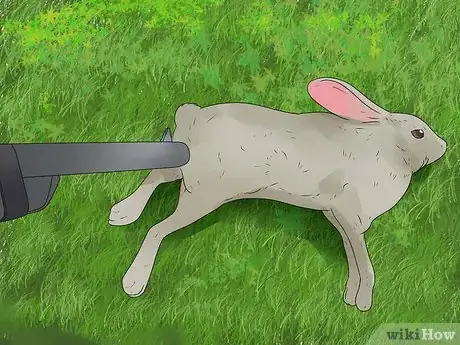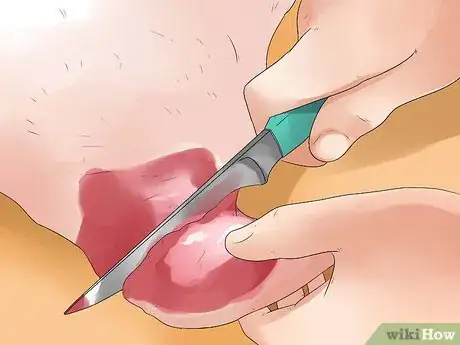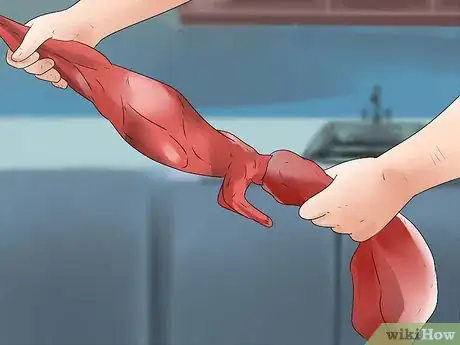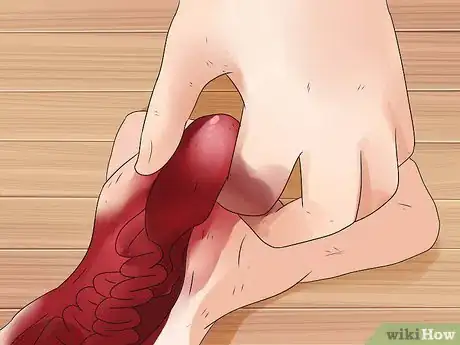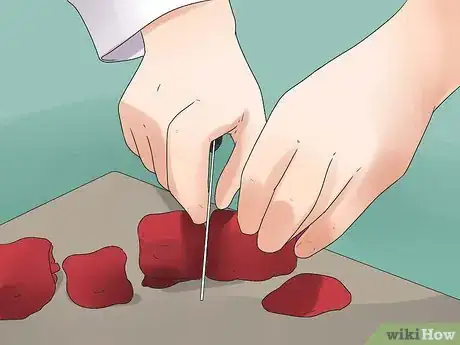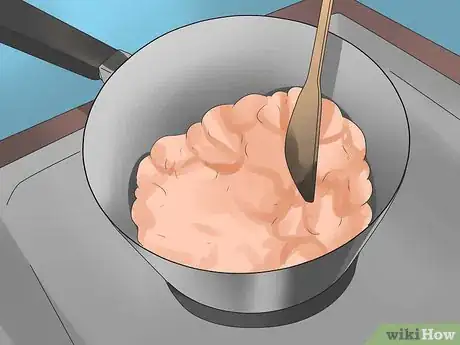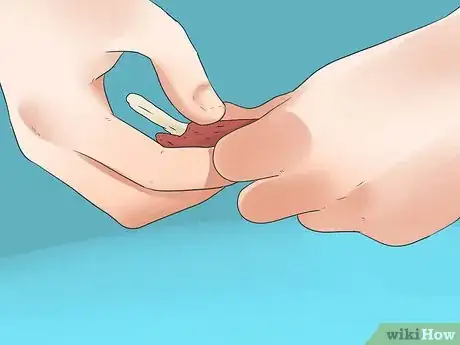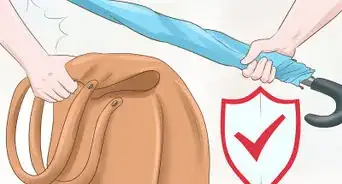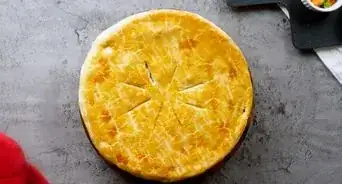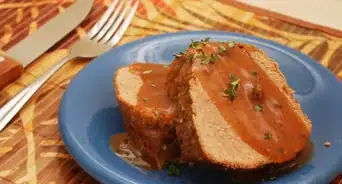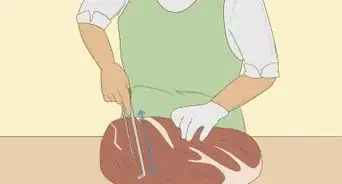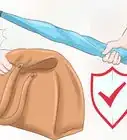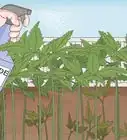wikiHow is a “wiki,” similar to Wikipedia, which means that many of our articles are co-written by multiple authors. To create this article, 36 people, some anonymous, worked to edit and improve it over time.
This article has been viewed 297,069 times.
Learn more...
Wild rabbits can decimate an unfenced garden and level every barely-edible piece of green. By killing and eating these rabbits, you not only protect the native vegetation, but also get the nutrients from the plants they ate. Here are some tips on killing, preparing, and eating these animals.
Steps
Hunting the rabbit
-
1Rabbits, cottontails in particular, can be killed with an air rifle or small "toy" 50-lb crossbow. If you're in an area where guns are tolerated, a .22 works well, with good accuracy. Typically, cottontail ("bunny") rabbits don't run away to escape; they "hide", often in plain sight behind the nearest bush, giving you a clear shot. Head shots are best, especially with anything more powerful than an airgun, as even a .22 will destroy meat, making rabbits more difficult to butcher. There are also ways to trap them.
-
2If you merely wound the animal, kill it as quickly and painlessly as possible. A crossbow bolt, BB, or a bullet through its brain works, as well as beheading it.
Preparing the rabbit
-
1Cut off the lower half of each leg. Also cut off the head.
-
2Peel back the skin at the neck. Grab one of the front legs by the muscle, and peel off the skin. This is similar in manner to removing a sock from a foot. If you're not going to use it, compost it, as with other parts that you won't eat. A quick, strong pull on the tail will usually suffice to get the white piece of fur off it, if it didn't come off with the rest (it usually doesn't).
-
3Starting at the neck or just below the rib cage, cut through the belly as far as you can. Then cut between the hind legs to expose the end of the small intestine.
-
4Remove the guts, keeping the liver and kidneys, if desired. The organ meats are tasty, but can be quite "gamey" as well, depending on the animal's diet (for that matter, the whole animal is sometimes unpalatably gamey, but still edible).
- (Keeping the liver, a real delicacy!)
- Remove the greenish gland embedded in the liver, making sure not to puncture it, so the bile doesn't taint the meat.
Cooking the rabbit
-
1Chop the rabbit into pieces for easier cooking.
-
2Pan-fry the meat. This can be done with or without flouring or breading it first, but pan-frying is a first step to many rabbit recipes. It, of course, can be eaten at this point without further preparation, especially if you're hungry; and if the meat is too gamey, you may want to find out now before putting it into a stew.
-
3At this point, if there's anything left, de-bone the rabbit and prepare it according to your favorite recipe.
- For example, pan-fry the rabbit in some wine, then some water. Let it cook for 45 minutes, adding the water gradually over the cooking time. Just be sure that it never runs out of water or it may burn. When done, turn off the heat and cover the rabbit pieces with lemon tree leaves (5-10 leaves). Leave the rabbit covered in lemon leaves with the pot closed, for 5-10 minutes, so that the aroma of the lemon gets into the meat. Then remove the leaves (they are not edible). Delicious!
Community Q&A
-
QuestionCan I eat rabbit that's been bitten by a rattlesnake?
 Community AnswerNo, that would be a very bad idea. There is a large possibility that the rabbit could have been poisoned. That is not a risk that you would want to take.
Community AnswerNo, that would be a very bad idea. There is a large possibility that the rabbit could have been poisoned. That is not a risk that you would want to take. -
QuestionCan I eat rabbit all year around?
 Maddy1229Community AnswerMost definitely. Just be sure to hunt at the appropriate time of the year according to your state, county or parish fish and game regulations. You might also need a hunting license.
Maddy1229Community AnswerMost definitely. Just be sure to hunt at the appropriate time of the year according to your state, county or parish fish and game regulations. You might also need a hunting license. -
QuestionCan I boil a rabbit?
 Community AnswerYes. Rabbit stew or just plain boiled rabbit is delicious when you add a few herbs and vegetables for flavor.
Community AnswerYes. Rabbit stew or just plain boiled rabbit is delicious when you add a few herbs and vegetables for flavor.
Warnings
- Be careful to remove any BBs or bullets as soon as possible. Metal poisoning and cracked teeth can occur.⧼thumbs_response⧽
- To avoid risk of parasite infestation, always cook rabbits "well done" before eating. For the same reason, compost what you don't use, rather than giving them to dogs or other domestic animals.⧼thumbs_response⧽
- Care should be taken when composting animal parts to ensure safety of the finished compost. Some areas, such as water conservation districts, have laws against composting animal parts. Check with local law enforcement for acceptable disposal methods.⧼thumbs_response⧽
- Rabbits carry ticks or other vermin which can cause disease (tularemia and bubonic plague, for example), particularly in May to August. Wear appropriate protective clothing while carrying and butchering them. Certain rabbits have the risk of carrying Tularemia, or rabbit fever. This is a disease caused by bacterium, that can be transmitted to humans via skin contact and through the respiratory tract. It is advised that you wear disposable gloves and a mask.⧼thumbs_response⧽
References
- This research was made possible, in part, by a land grant from the City of the Sun Foundation, though the specifics of the research were not coordinated nor endorsed by COSF.
About This Article
To eat wild rabbit, start by cutting off the rabbit's head and the lower half of each leg. Then, remove the skin and the guts. Next, chop the rabbit up into small pieces and pan fry it before de-boning it. After you de-bone the meat, use it in your favorite recipes. Just make sure you cook the rabbit until it's well-done since rabbits can carry parasites and diseases. To learn how to hunt wild rabbit, keep reading!
